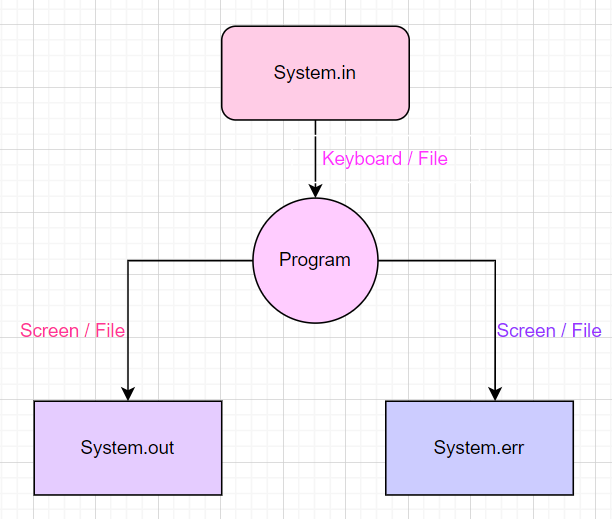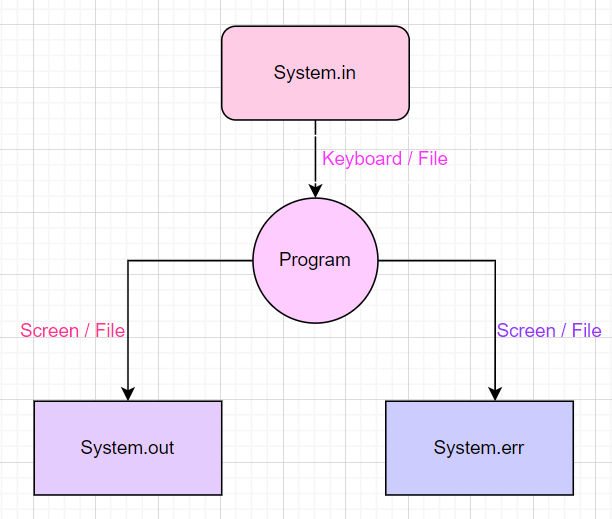Chapter 1 - Input and Output in Java
 Vaishnavi Dwivedi
Vaishnavi Dwivedi
Input and output (I/O) operations are fundamental to any program as they allow data to be received (input) and sent out (output).
In Java, the java.io package provides extensive classes and methods for handling I/O operations. At the core of Java's I/O system is the concept of streams.
What is a Stream?
A stream in Java is a continuous flow of data. It represents a sequence of bytes (or characters) coming from a source (input) or going to a destination (output).
Streams abstract the underlying source or destination, allowing developers to focus on reading or writing data without worrying about the specific details of the input/output device.
Streams are categorized into:
Input Stream: Reads data from a source (e.g., file, keyboard). - important
Output Stream: Writes data to a destination (e.g., file, console). - important
Byte Streams: For reading and writing binary data.
Character Streams: For reading and writing text data.

Default Streams in Java
Before exploring different input/output streams, let’s take a look at the three standard/default streams in Java, which are also the most commonly used:
System.in: Standard input stream, typically used to read data from the keyboard.System.out: Standard output stream, used to print results to the console or screen.System.err: Standard error stream, used to output error messages to the console.

Example:
Using System.in
Scanner scanner = new Scanner(System.in): TheScannerclass is used to read input fromSystem.in.The program prompts the user to enter their name and age, then prints the values entered by the user.
import java.util.Scanner;
public class SystemInExample {
public static void main(String[] args) {
Scanner scanner = new Scanner(System.in);
// Reading a string input from the user
System.out.print("Enter your name: ");
String name = scanner.nextLine();
// Reading an integer input from the user
System.out.print("Enter your age: ");
int age = scanner.nextInt();
System.out.println("Name: " + name);
System.out.println("Age: " + age);
scanner.close();
}
}
Using System.err
System.err is typically used to print error messages. It behaves like System.out, but it’s used for outputting errors and warnings.
System.err.println("Error: The number cannot be negative."): Prints the error message to the console using the error stream, System.err.
public class SystemErrExample {
public static void main(String[] args) {
int number = -5;
// Check if the number is positive
if (number < 0) {
System.err.println("Error: The number cannot be negative.");
} else {
System.out.println("The number is " + number);
}
}
}
Using System.out
public class OutputExample {
public static void main(String[] args) {
System.out.println("Hello, World!"); // with ln means next line
// without ln means continues - doesnt move to next line
System.out.print("Hello");
System.out.print(" World!");
// through this we can format thee output
int num = 100;
System.out.printf("Number: %d", num);
}
}
// output
Hello, World!
Hello World!
// formated as number
Number: 100
Types of Streams
1. Byte Streams
Byte streams are used to handle raw binary data and read/write data byte by byte. They are ideal for dealing with file I/O, such as copying files.
Input Streams:
FileInputStream,BufferedInputStream,DataInputStreamOutput Streams:
FileOutputStream,BufferedOutputStream,DataOutputStream
Example: Copying a File with Byte Streams
import java.io.FileInputStream;
import java.io.FileOutputStream;
import java.io.IOException;
public class ByteStreamExample {
public static void main(String[] args) {
FileInputStream inputStream = null;
FileOutputStream outputStream = null;
try {
// Open a file to read
inputStream = new FileInputStream("source.txt");
// Open a file to write
outputStream = new FileOutputStream("destination.txt");
// Read byte by byte and write it to another file
int byteData;
while ((byteData = inputStream.read()) != -1) {
outputStream.write(byteData);
}
System.out.println("File copied successfully!");
} catch (IOException e) {
e.printStackTrace();
} finally {
try {
// Close streams
if (inputStream != null) inputStream.close();
if (outputStream != null) outputStream.close();
} catch (IOException ex) {
ex.printStackTrace();
}
}
}
}
Explanation:
FileInputStream: Reads bytes from a source file.FileOutputStream: Writes bytes to a destination file.The program reads each byte from
source.txtand writes it todestination.txt.
2. Character Streams
Character streams handle text data, using Unicode to automatically encode and decode characters. They read/write data character by character and are typically used when working with text files.
Input Streams:
FileReader,BufferedReader,InputStreamReaderOutput Streams:
FileWriter,BufferedWriter,PrintWriter
Example: Reading a File with Character Stream
import java.io.FileReader;
import java.io.IOException;
public class CharacterStreamExample {
public static void main(String[] args) {
FileReader reader = null;
try {
reader = new FileReader("test.txt");
// Read and display each character from the file
int character;
while ((character = reader.read()) != -1) {
System.out.print((char) character);
}
} catch (IOException e) {
e.printStackTrace();
} finally {
try {
if (reader != null) reader.close();
} catch (IOException ex) {
ex.printStackTrace();
}
}
}
}
Explanation:
FileReader: Reads characters from a file.The program reads each character from
test.txtand prints it to the console.
Summary Notes:
Stream abstraction: Streams in Java abstract the details of I/O sources and destinations, allowing you to focus on reading or writing data without worrying about how it is stored or transferred.
Standard streams:
System.in: Used for standard input (keyboard).System.out: Used to standard output( file or console).System.err: Used to show output in error format.import java.util.Scanner; public class SystemInExample { public static void main(String[] args) { Scanner scanner = new Scanner(System.in); System.out.print("Enter your name: "); String name = scanner.nextLine(); // Reads input from keyboard System.out.println("Hello, " + name + "!"); // system.err int number = -1; if (number < 0) { System.err.println("Error: The number cannot be negative."); // Outputs error to the console } scanner.close(); } }
Byte streams are used for handling raw binary data.
Character streams are used for handling text data with automatic character encoding/decoding.
Error handling: Always remember to handle I/O exceptions (e.g.,
IOException) properly, especially when working with files or streams.Closing streams: Always close streams in the
finallyblock or use try-with-resources to ensure streams are closed even if an exception occurs.
Subscribe to my newsletter
Read articles from Vaishnavi Dwivedi directly inside your inbox. Subscribe to the newsletter, and don't miss out.
Written by
